Financial Analysis and Investment Appraisal Report for DD Plc Projects
VerifiedAdded on 2023/06/10
|8
|1450
|169
Report
AI Summary
The report analyzes investment appraisal techniques used by DD Plc, a UK-based vegetarian food company, to evaluate potential projects in smoothies and non-dairy milk. It computes the payback period and net present value (NPV) for each project, demonstrating the importance of these methods in determining the financial viability of investments. The analysis reveals that Project A (Smoothies) is more suitable for expansion. The report also explores financial factors like income and costs, and non-financial factors like market position and customer satisfaction that aid business decision-making. This report is crucial for understanding the application of financial tools in investment decisions and offers insights into the factors that influence the success of business ventures.

business decision
making
making
Paraphrase This Document
Need a fresh take? Get an instant paraphrase of this document with our AI Paraphraser
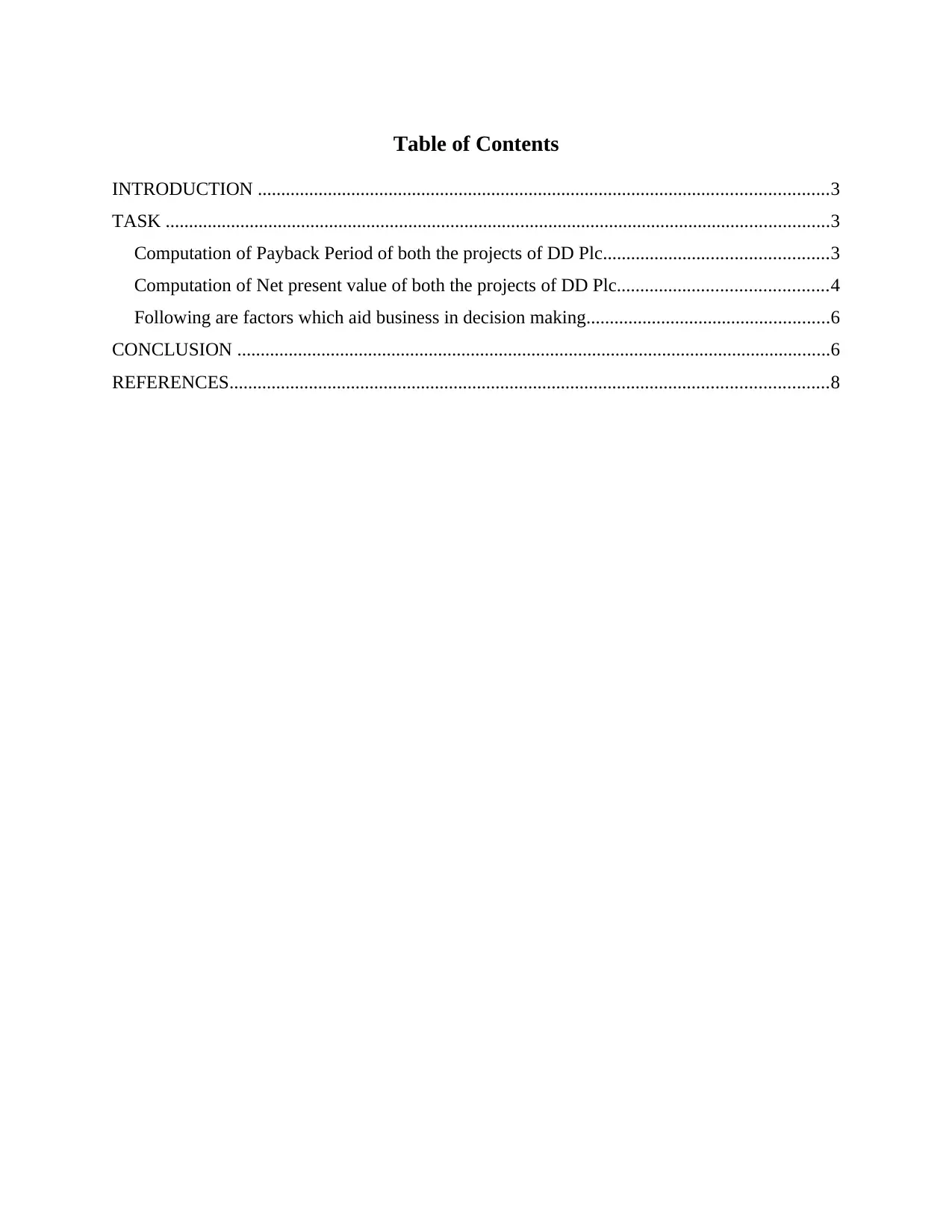
Table of Contents
INTRODUCTION ..........................................................................................................................3
TASK ..............................................................................................................................................3
Computation of Payback Period of both the projects of DD Plc................................................3
Computation of Net present value of both the projects of DD Plc.............................................4
Following are factors which aid business in decision making....................................................6
CONCLUSION ...............................................................................................................................6
REFERENCES................................................................................................................................8
INTRODUCTION ..........................................................................................................................3
TASK ..............................................................................................................................................3
Computation of Payback Period of both the projects of DD Plc................................................3
Computation of Net present value of both the projects of DD Plc.............................................4
Following are factors which aid business in decision making....................................................6
CONCLUSION ...............................................................................................................................6
REFERENCES................................................................................................................................8
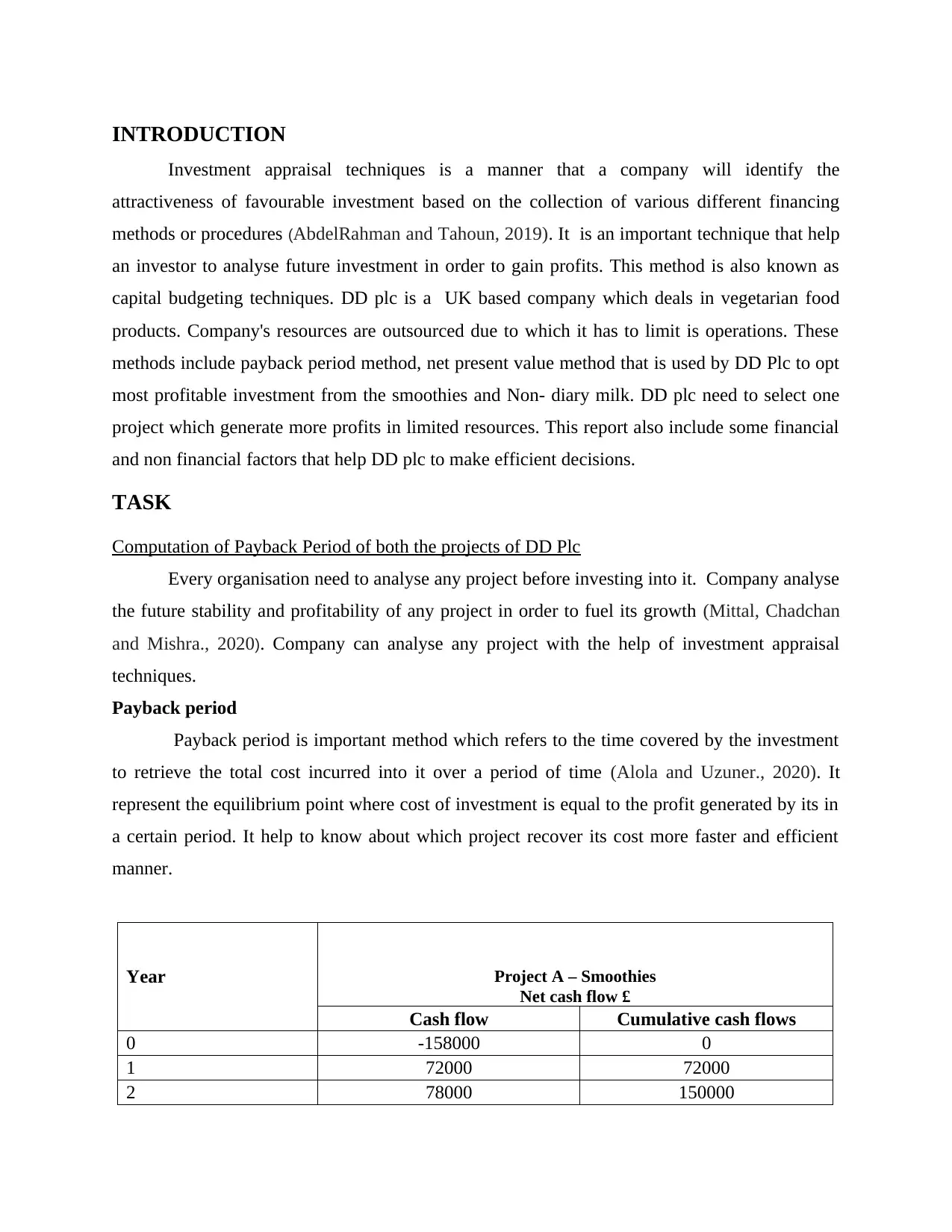
INTRODUCTION
Investment appraisal techniques is a manner that a company will identify the
attractiveness of favourable investment based on the collection of various different financing
methods or procedures (AbdelRahman and Tahoun, 2019). It is an important technique that help
an investor to analyse future investment in order to gain profits. This method is also known as
capital budgeting techniques. DD plc is a UK based company which deals in vegetarian food
products. Company's resources are outsourced due to which it has to limit is operations. These
methods include payback period method, net present value method that is used by DD Plc to opt
most profitable investment from the smoothies and Non- diary milk. DD plc need to select one
project which generate more profits in limited resources. This report also include some financial
and non financial factors that help DD plc to make efficient decisions.
TASK
Computation of Payback Period of both the projects of DD Plc
Every organisation need to analyse any project before investing into it. Company analyse
the future stability and profitability of any project in order to fuel its growth (Mittal, Chadchan
and Mishra., 2020). Company can analyse any project with the help of investment appraisal
techniques.
Payback period
Payback period is important method which refers to the time covered by the investment
to retrieve the total cost incurred into it over a period of time (Alola and Uzuner., 2020). It
represent the equilibrium point where cost of investment is equal to the profit generated by its in
a certain period. It help to know about which project recover its cost more faster and efficient
manner.
Year Project A – Smoothies
Net cash flow £
Cash flow Cumulative cash flows
0 -158000 0
1 72000 72000
2 78000 150000
Investment appraisal techniques is a manner that a company will identify the
attractiveness of favourable investment based on the collection of various different financing
methods or procedures (AbdelRahman and Tahoun, 2019). It is an important technique that help
an investor to analyse future investment in order to gain profits. This method is also known as
capital budgeting techniques. DD plc is a UK based company which deals in vegetarian food
products. Company's resources are outsourced due to which it has to limit is operations. These
methods include payback period method, net present value method that is used by DD Plc to opt
most profitable investment from the smoothies and Non- diary milk. DD plc need to select one
project which generate more profits in limited resources. This report also include some financial
and non financial factors that help DD plc to make efficient decisions.
TASK
Computation of Payback Period of both the projects of DD Plc
Every organisation need to analyse any project before investing into it. Company analyse
the future stability and profitability of any project in order to fuel its growth (Mittal, Chadchan
and Mishra., 2020). Company can analyse any project with the help of investment appraisal
techniques.
Payback period
Payback period is important method which refers to the time covered by the investment
to retrieve the total cost incurred into it over a period of time (Alola and Uzuner., 2020). It
represent the equilibrium point where cost of investment is equal to the profit generated by its in
a certain period. It help to know about which project recover its cost more faster and efficient
manner.
Year Project A – Smoothies
Net cash flow £
Cash flow Cumulative cash flows
0 -158000 0
1 72000 72000
2 78000 150000
⊘ This is a preview!⊘
Do you want full access?
Subscribe today to unlock all pages.

Trusted by 1+ million students worldwide
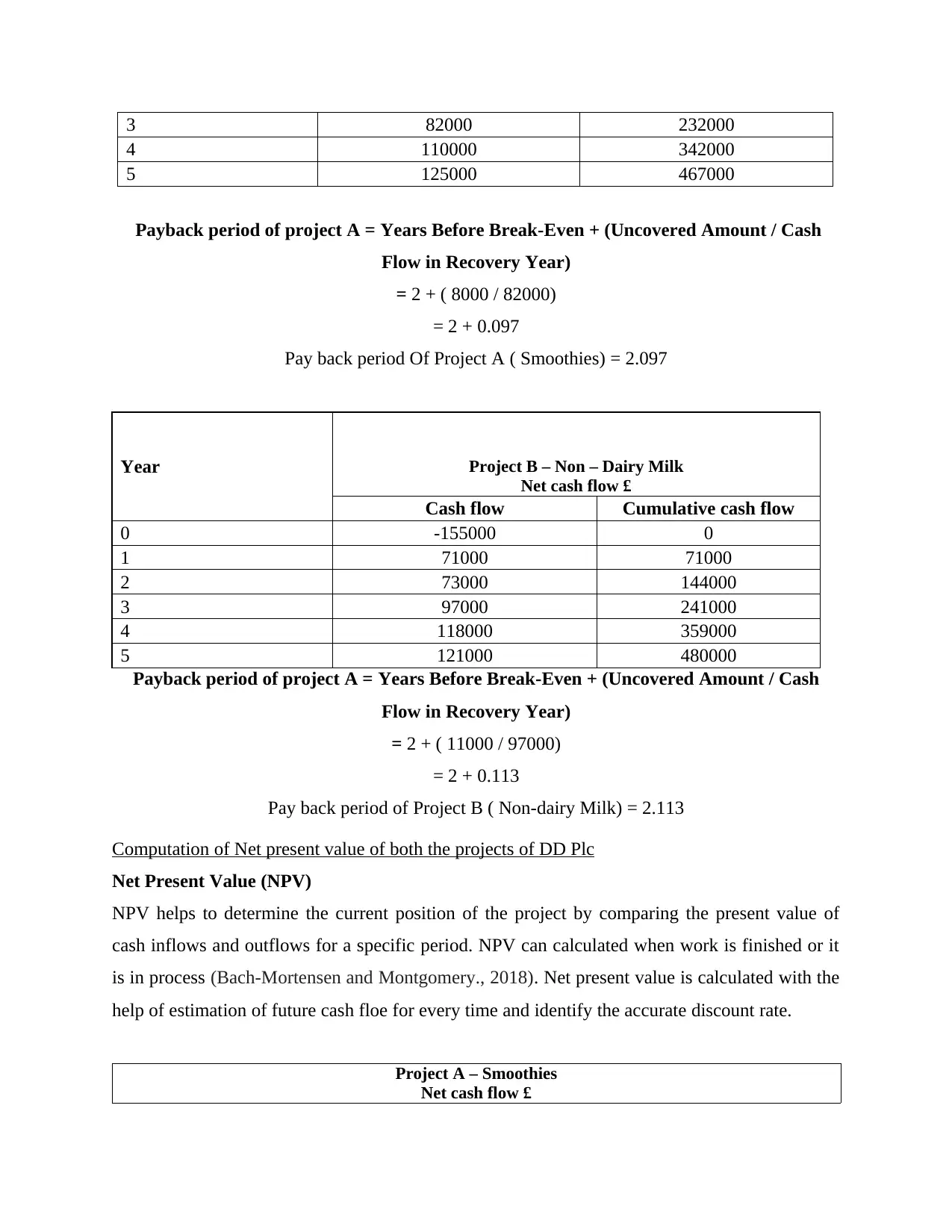
3 82000 232000
4 110000 342000
5 125000 467000
Payback period of project A = Years Before Break-Even + (Uncovered Amount / Cash
Flow in Recovery Year)
= 2 + ( 8000 / 82000)
= 2 + 0.097
Pay back period Of Project A ( Smoothies) = 2.097
Year Project B – Non – Dairy Milk
Net cash flow £
Cash flow Cumulative cash flow
0 -155000 0
1 71000 71000
2 73000 144000
3 97000 241000
4 118000 359000
5 121000 480000
Payback period of project A = Years Before Break-Even + (Uncovered Amount / Cash
Flow in Recovery Year)
= 2 + ( 11000 / 97000)
= 2 + 0.113
Pay back period of Project B ( Non-dairy Milk) = 2.113
Computation of Net present value of both the projects of DD Plc
Net Present Value (NPV)
NPV helps to determine the current position of the project by comparing the present value of
cash inflows and outflows for a specific period. NPV can calculated when work is finished or it
is in process (Bach-Mortensen and Montgomery., 2018). Net present value is calculated with the
help of estimation of future cash floe for every time and identify the accurate discount rate.
Project A – Smoothies
Net cash flow £
4 110000 342000
5 125000 467000
Payback period of project A = Years Before Break-Even + (Uncovered Amount / Cash
Flow in Recovery Year)
= 2 + ( 8000 / 82000)
= 2 + 0.097
Pay back period Of Project A ( Smoothies) = 2.097
Year Project B – Non – Dairy Milk
Net cash flow £
Cash flow Cumulative cash flow
0 -155000 0
1 71000 71000
2 73000 144000
3 97000 241000
4 118000 359000
5 121000 480000
Payback period of project A = Years Before Break-Even + (Uncovered Amount / Cash
Flow in Recovery Year)
= 2 + ( 11000 / 97000)
= 2 + 0.113
Pay back period of Project B ( Non-dairy Milk) = 2.113
Computation of Net present value of both the projects of DD Plc
Net Present Value (NPV)
NPV helps to determine the current position of the project by comparing the present value of
cash inflows and outflows for a specific period. NPV can calculated when work is finished or it
is in process (Bach-Mortensen and Montgomery., 2018). Net present value is calculated with the
help of estimation of future cash floe for every time and identify the accurate discount rate.
Project A – Smoothies
Net cash flow £
Paraphrase This Document
Need a fresh take? Get an instant paraphrase of this document with our AI Paraphraser
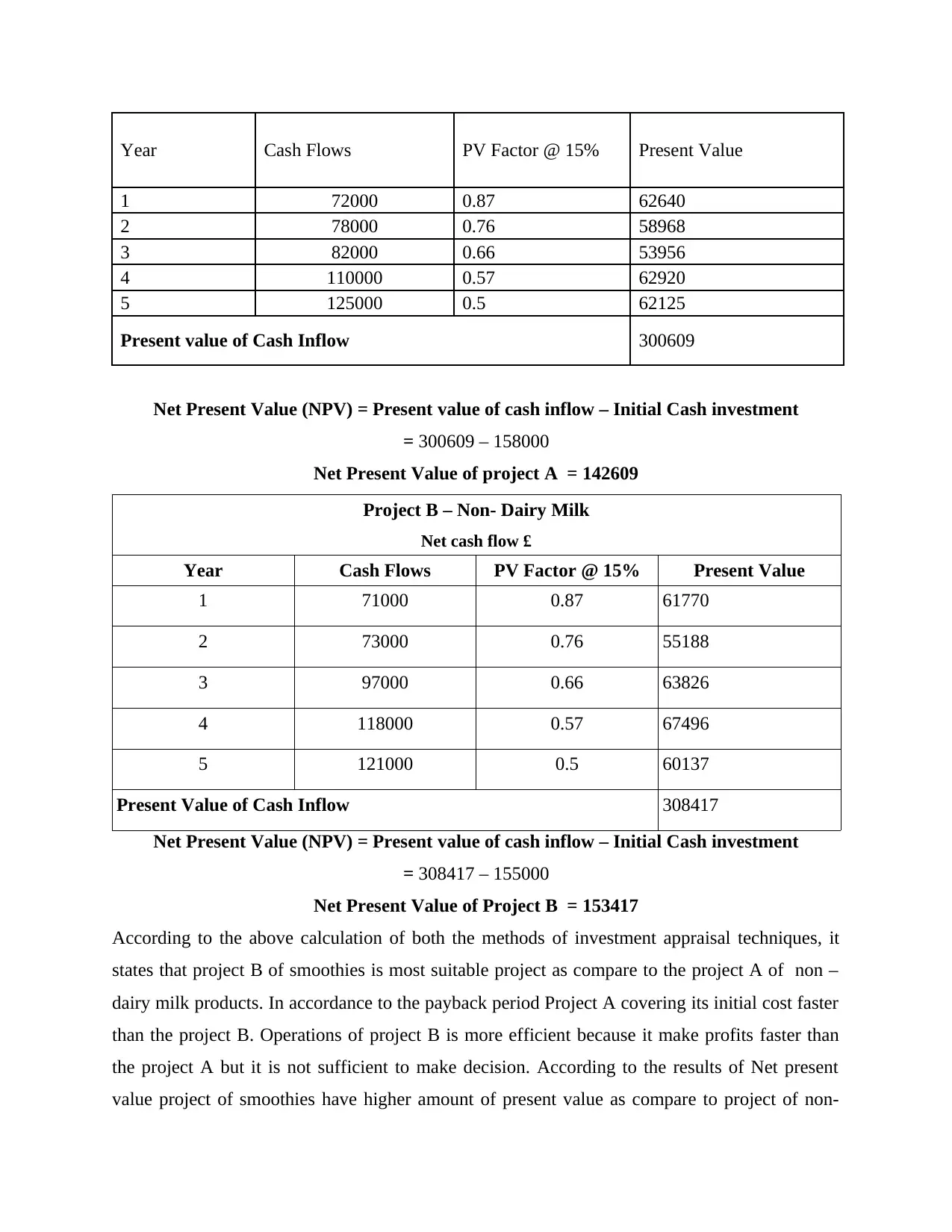
Year Cash Flows PV Factor @ 15% Present Value
1 72000 0.87 62640
2 78000 0.76 58968
3 82000 0.66 53956
4 110000 0.57 62920
5 125000 0.5 62125
Present value of Cash Inflow 300609
Net Present Value (NPV) = Present value of cash inflow – Initial Cash investment
= 300609 – 158000
Net Present Value of project A = 142609
Project B – Non- Dairy Milk
Net cash flow £
Year Cash Flows PV Factor @ 15% Present Value
1 71000 0.87 61770
2 73000 0.76 55188
3 97000 0.66 63826
4 118000 0.57 67496
5 121000 0.5 60137
Present Value of Cash Inflow 308417
Net Present Value (NPV) = Present value of cash inflow – Initial Cash investment
= 308417 – 155000
Net Present Value of Project B = 153417
According to the above calculation of both the methods of investment appraisal techniques, it
states that project B of smoothies is most suitable project as compare to the project A of non –
dairy milk products. In accordance to the payback period Project A covering its initial cost faster
than the project B. Operations of project B is more efficient because it make profits faster than
the project A but it is not sufficient to make decision. According to the results of Net present
value project of smoothies have higher amount of present value as compare to project of non-
1 72000 0.87 62640
2 78000 0.76 58968
3 82000 0.66 53956
4 110000 0.57 62920
5 125000 0.5 62125
Present value of Cash Inflow 300609
Net Present Value (NPV) = Present value of cash inflow – Initial Cash investment
= 300609 – 158000
Net Present Value of project A = 142609
Project B – Non- Dairy Milk
Net cash flow £
Year Cash Flows PV Factor @ 15% Present Value
1 71000 0.87 61770
2 73000 0.76 55188
3 97000 0.66 63826
4 118000 0.57 67496
5 121000 0.5 60137
Present Value of Cash Inflow 308417
Net Present Value (NPV) = Present value of cash inflow – Initial Cash investment
= 308417 – 155000
Net Present Value of Project B = 153417
According to the above calculation of both the methods of investment appraisal techniques, it
states that project B of smoothies is most suitable project as compare to the project A of non –
dairy milk products. In accordance to the payback period Project A covering its initial cost faster
than the project B. Operations of project B is more efficient because it make profits faster than
the project A but it is not sufficient to make decision. According to the results of Net present
value project of smoothies have higher amount of present value as compare to project of non-
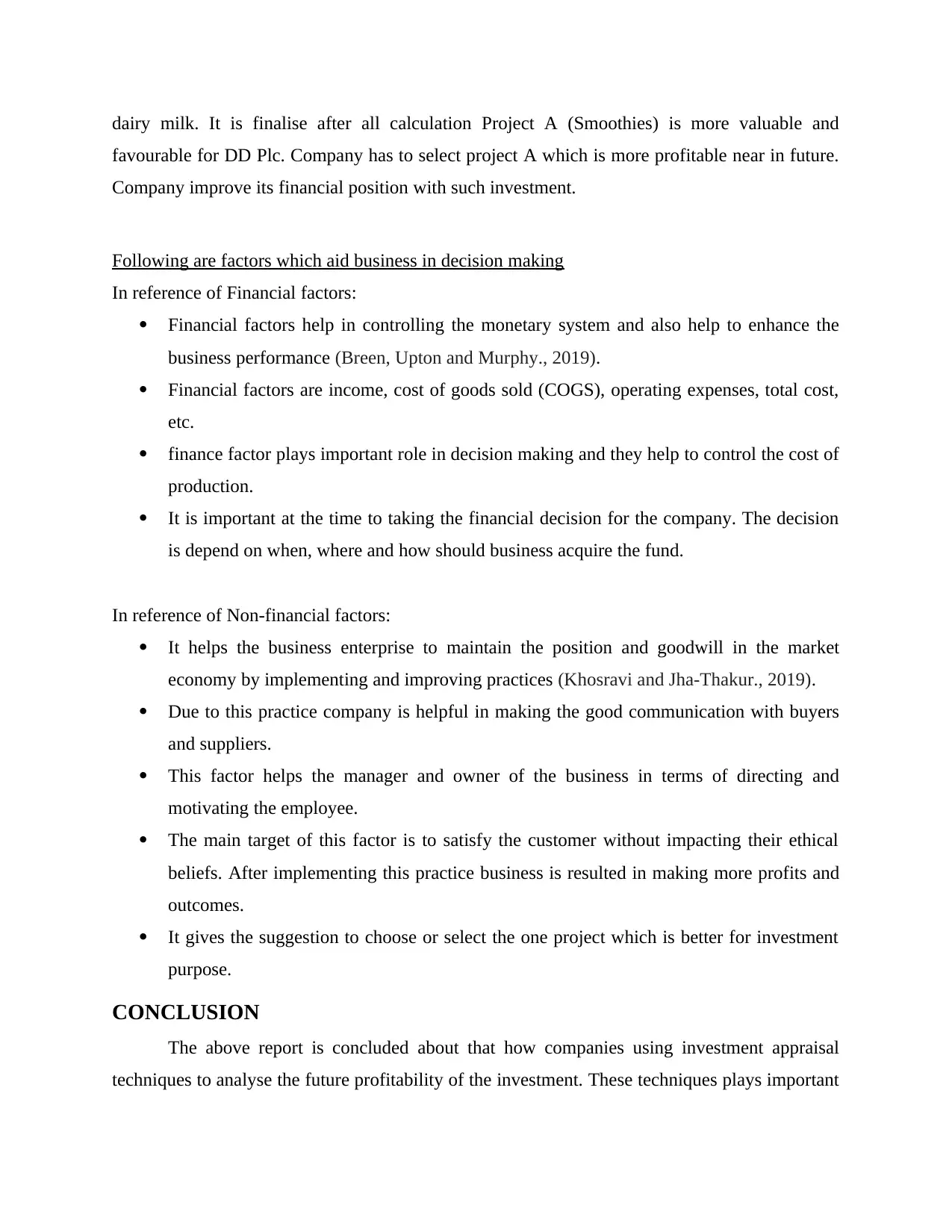
dairy milk. It is finalise after all calculation Project A (Smoothies) is more valuable and
favourable for DD Plc. Company has to select project A which is more profitable near in future.
Company improve its financial position with such investment.
Following are factors which aid business in decision making
In reference of Financial factors:
Financial factors help in controlling the monetary system and also help to enhance the
business performance (Breen, Upton and Murphy., 2019).
Financial factors are income, cost of goods sold (COGS), operating expenses, total cost,
etc.
finance factor plays important role in decision making and they help to control the cost of
production.
It is important at the time to taking the financial decision for the company. The decision
is depend on when, where and how should business acquire the fund.
In reference of Non-financial factors:
It helps the business enterprise to maintain the position and goodwill in the market
economy by implementing and improving practices (Khosravi and Jha-Thakur., 2019).
Due to this practice company is helpful in making the good communication with buyers
and suppliers.
This factor helps the manager and owner of the business in terms of directing and
motivating the employee.
The main target of this factor is to satisfy the customer without impacting their ethical
beliefs. After implementing this practice business is resulted in making more profits and
outcomes.
It gives the suggestion to choose or select the one project which is better for investment
purpose.
CONCLUSION
The above report is concluded about that how companies using investment appraisal
techniques to analyse the future profitability of the investment. These techniques plays important
favourable for DD Plc. Company has to select project A which is more profitable near in future.
Company improve its financial position with such investment.
Following are factors which aid business in decision making
In reference of Financial factors:
Financial factors help in controlling the monetary system and also help to enhance the
business performance (Breen, Upton and Murphy., 2019).
Financial factors are income, cost of goods sold (COGS), operating expenses, total cost,
etc.
finance factor plays important role in decision making and they help to control the cost of
production.
It is important at the time to taking the financial decision for the company. The decision
is depend on when, where and how should business acquire the fund.
In reference of Non-financial factors:
It helps the business enterprise to maintain the position and goodwill in the market
economy by implementing and improving practices (Khosravi and Jha-Thakur., 2019).
Due to this practice company is helpful in making the good communication with buyers
and suppliers.
This factor helps the manager and owner of the business in terms of directing and
motivating the employee.
The main target of this factor is to satisfy the customer without impacting their ethical
beliefs. After implementing this practice business is resulted in making more profits and
outcomes.
It gives the suggestion to choose or select the one project which is better for investment
purpose.
CONCLUSION
The above report is concluded about that how companies using investment appraisal
techniques to analyse the future profitability of the investment. These techniques plays important
⊘ This is a preview!⊘
Do you want full access?
Subscribe today to unlock all pages.

Trusted by 1+ million students worldwide

role in decision making process. These techniques includes various methods, where DD Plc
using NPV and Payback period method to analysing the two project and made decision
accordingly. It is recommended on the basis of above calculation project A of smoothies for
expansion purpose. This report also explain the factors which affect the business operations.
using NPV and Payback period method to analysing the two project and made decision
accordingly. It is recommended on the basis of above calculation project A of smoothies for
expansion purpose. This report also explain the factors which affect the business operations.
Paraphrase This Document
Need a fresh take? Get an instant paraphrase of this document with our AI Paraphraser
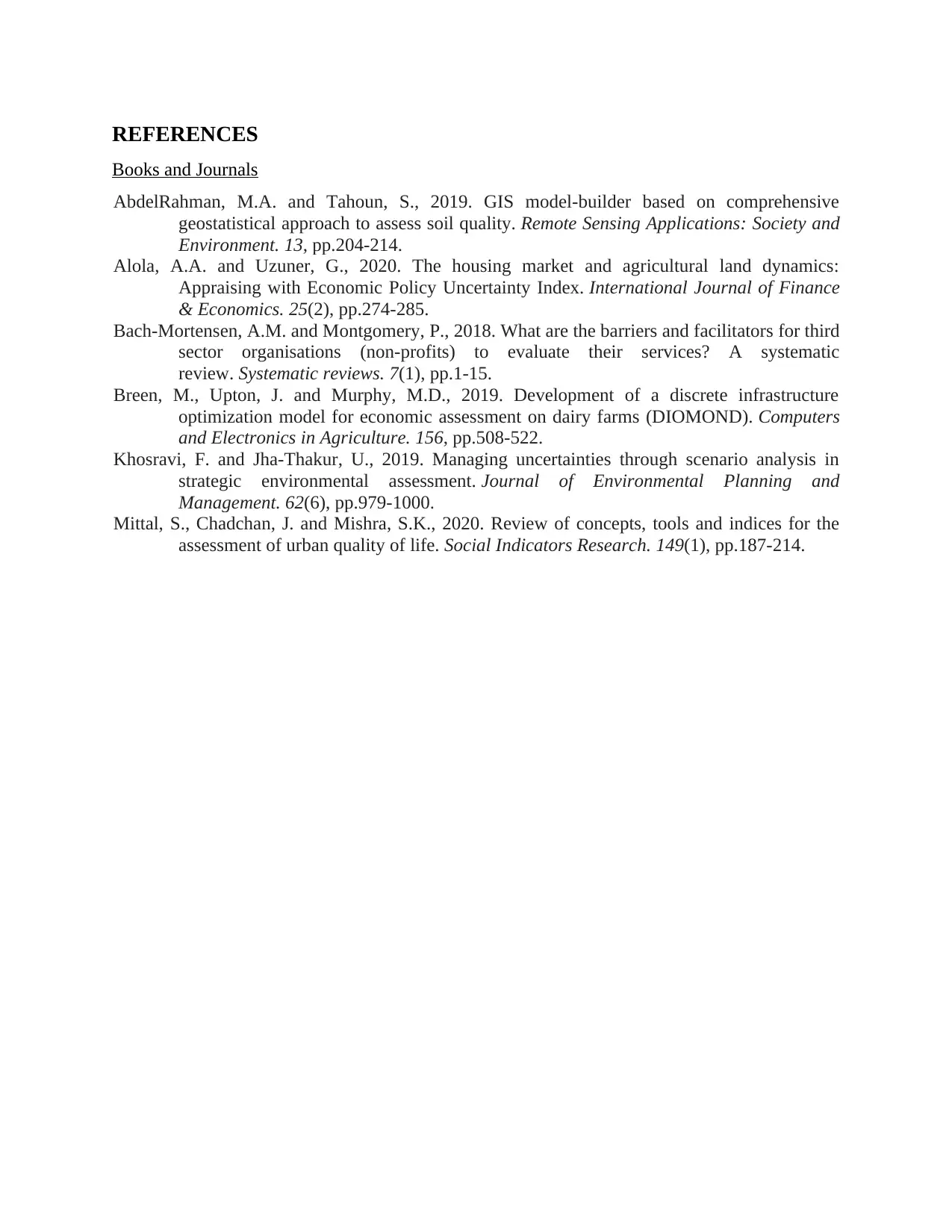
REFERENCES
Books and Journals
AbdelRahman, M.A. and Tahoun, S., 2019. GIS model-builder based on comprehensive
geostatistical approach to assess soil quality. Remote Sensing Applications: Society and
Environment. 13, pp.204-214.
Alola, A.A. and Uzuner, G., 2020. The housing market and agricultural land dynamics:
Appraising with Economic Policy Uncertainty Index. International Journal of Finance
& Economics. 25(2), pp.274-285.
Bach-Mortensen, A.M. and Montgomery, P., 2018. What are the barriers and facilitators for third
sector organisations (non-profits) to evaluate their services? A systematic
review. Systematic reviews. 7(1), pp.1-15.
Breen, M., Upton, J. and Murphy, M.D., 2019. Development of a discrete infrastructure
optimization model for economic assessment on dairy farms (DIOMOND). Computers
and Electronics in Agriculture. 156, pp.508-522.
Khosravi, F. and Jha-Thakur, U., 2019. Managing uncertainties through scenario analysis in
strategic environmental assessment. Journal of Environmental Planning and
Management. 62(6), pp.979-1000.
Mittal, S., Chadchan, J. and Mishra, S.K., 2020. Review of concepts, tools and indices for the
assessment of urban quality of life. Social Indicators Research. 149(1), pp.187-214.
Books and Journals
AbdelRahman, M.A. and Tahoun, S., 2019. GIS model-builder based on comprehensive
geostatistical approach to assess soil quality. Remote Sensing Applications: Society and
Environment. 13, pp.204-214.
Alola, A.A. and Uzuner, G., 2020. The housing market and agricultural land dynamics:
Appraising with Economic Policy Uncertainty Index. International Journal of Finance
& Economics. 25(2), pp.274-285.
Bach-Mortensen, A.M. and Montgomery, P., 2018. What are the barriers and facilitators for third
sector organisations (non-profits) to evaluate their services? A systematic
review. Systematic reviews. 7(1), pp.1-15.
Breen, M., Upton, J. and Murphy, M.D., 2019. Development of a discrete infrastructure
optimization model for economic assessment on dairy farms (DIOMOND). Computers
and Electronics in Agriculture. 156, pp.508-522.
Khosravi, F. and Jha-Thakur, U., 2019. Managing uncertainties through scenario analysis in
strategic environmental assessment. Journal of Environmental Planning and
Management. 62(6), pp.979-1000.
Mittal, S., Chadchan, J. and Mishra, S.K., 2020. Review of concepts, tools and indices for the
assessment of urban quality of life. Social Indicators Research. 149(1), pp.187-214.
1 out of 8